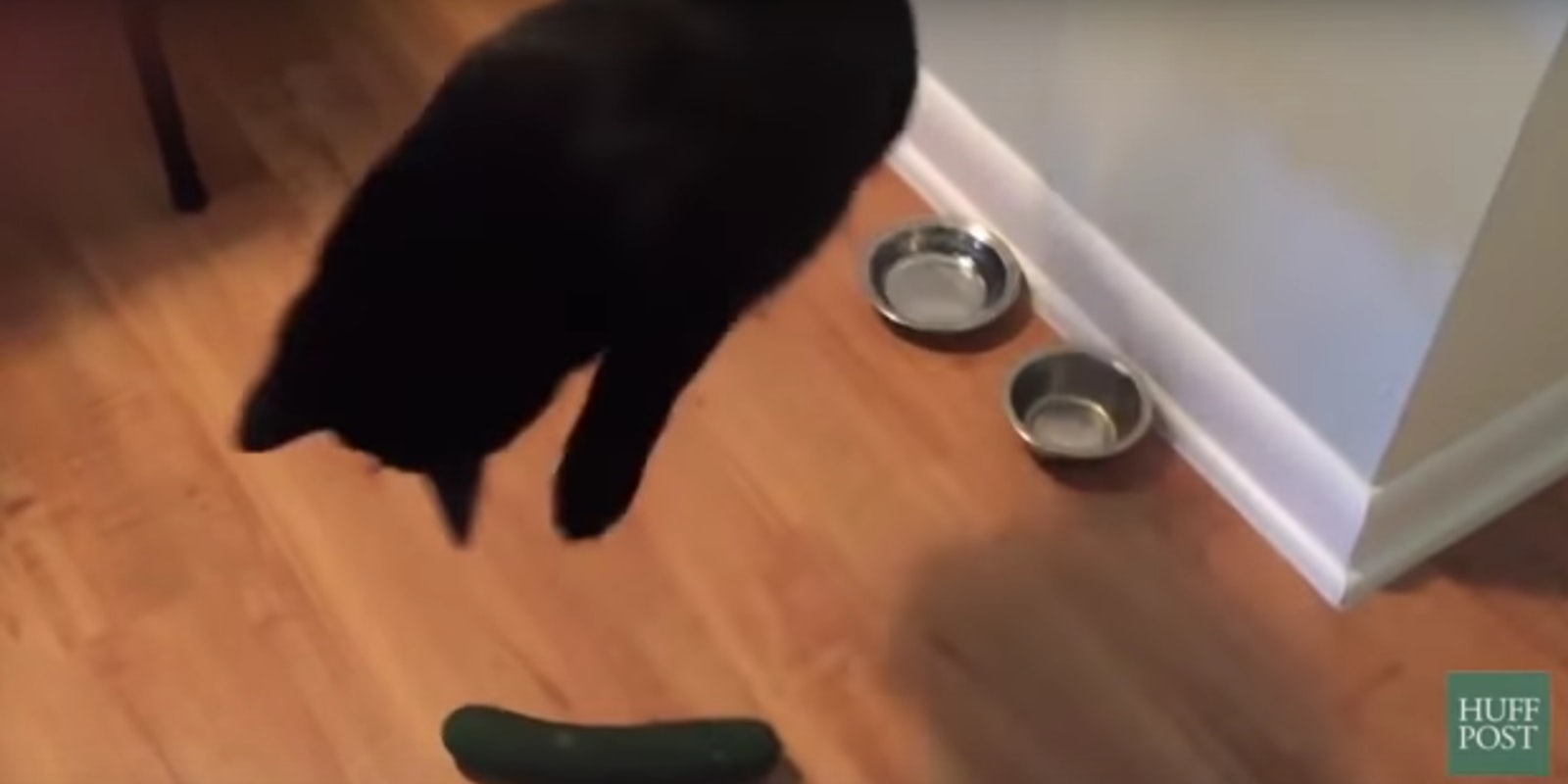People are scaring their cats with cucumbers. It’s been a meme for a little while now, but it became the subject of curiosity after Huffington Post made a supercut of cats getting startled by the sudden appearance of cucumbers.
National Geographic followed up with several interviews with cat behaviorists, who generally agreed that this is a cruel thing to do to your pet. But why?
Well, the answer is a bit complicated and murky.
First of all, we’re not really sure why cucumbers are so offensive to felines. I thought perhaps any unusual object might have the same effect, so as an experiment I tried it out on my own kitten, Mochi.
This is Mochi, a.k.a. Fleabag, Destroyer of Worlds:
View post on imgur.comHere’s her reaction to a variety of items placed behind her.
As you can see, there’s not much reaction. If anything, she’s intrigued by the objects, fearlessly sniffing and even nibbling at them. Granted, this is a terribly constructed experiment. There are no control trials—i.e. I never tried it out with a cucumber, zucchini, or any other similar items. I’ll get to why in a minute.
I will say I’m not surprised by Mochi’s (lack of) reaction. For one, I’ve never seen her startle in any real way. She’s never jumped in the air at a sudden stimulus, and she’s generally pretty unflappable. Her first trip to the vet involved her settling in for a nap right on the table. When I vacuum the floor, she definitely fears the machine but doesn’t run away into another room or even hide from it. It may be that cats that scare easy are the only ones affected by cucumbers. And maybe Mochi, having spent the first four months of her life fending for herself on the streets of Oakland, California, isn’t really so afraid of new things. Without knowing the cats in the videos, we can’t say for sure.
But that’s not why I never got to the cucumber phase of the test. I read the National Geographic article and questioned whether or not I should continue to try to startle Mochi. I contacted certified cat behavior consultant and author of Naughty No More, Marilyn Krieger, to get the scoop.
“I think it’s a very cruel thing to do,” Krieger said over the phone.
Here’s the thing about these scaring kitties videos: Many of the scares happen when the cat is either eating, entering a new room, or sleeping. Krieger said that cats associate the spaces they use for these activities as being safe. They’re vulnerable when they do these things and it’s pretty mean to take advantage of that. She added that she’s not sure why cucumbers in particular seem to elicit the reaction. She speculated that perhaps the cucumber resembles a snake or something about the smell or dark color is offensive to the cat, but she wasn’t sure.
But I wanted to know more. Is one time really that big a deal? Even if someone were mean enough to do it over and over, wouldn’t the cat learn that the cucumber wasn’t a threat?
When you scare your cat with a cucumber, you’re triggering an “acute stress response” or the flight or fight response. This basically is a very quick, instinctual reaction that causes the body to release a huge amount of cortisol (the stress hormone.) It’s probably not unlike when you sneak up behind and startle a friend.
However, while you, a human, have the cognitive capacity to realize you’re not in danger immediately after your friend scares you, it’s less clear what’s going on in the mind of the cat. Krieger said you could run the risk of them associating their feeding or sleeping spot with a fearful situation and avoiding it.
But, what about repeat exposure?
Krieger was rather upset by the idea that someone might do this to their cat repeatedly. “I would hope no one would do that and I don’t want to go there or suggest it.”
She said that she felt presenting the cucumber in such a way would be “flooding” the cat with a fearful stimulus. She drew a parallel with a person who is afraid of spiders. “You don’t suddenly introduce them to thousands of spiders,” Krieger said. “In other words, flooding can be very detrimental. And this is a cat, the cat doesn’t know you’re doing it for its own good.” Moreover, what good would come of getting a cat to be less afraid of a cucumber?
If you did, for whatever strange reason, want to get the cat to come to terms with the cucumber, she said it would probably be best to let the cat explore the cucumber on its own terms. In other words, place it within the cat’s sight and not where it will be surprised by its sudden appearance. She said that placing it with clothing that smells like you or petting the cat while it explores the cucumber might help it to associate the cucumber with a positive stimulus and become less afraid of it.
But it’s probably best just to keep the cucumber out of sight.
Screengrab via Link-Wall . com/YouTube
